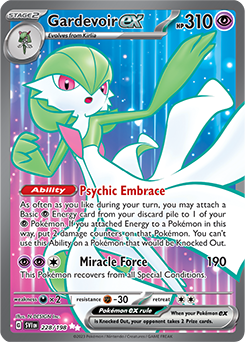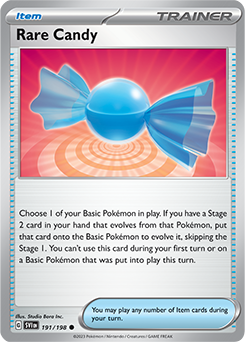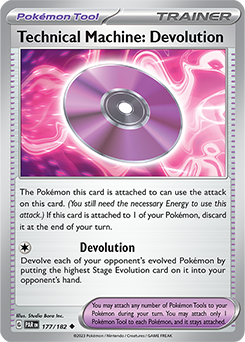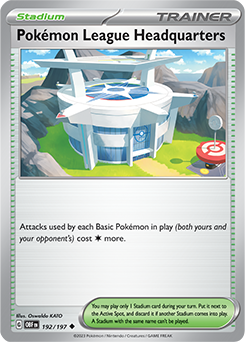Read on below to learn more about the new Temporal Forces expansion as part of Pokémon TCG: Scarlet & Violet.
Find out how Gardevoir ex has evolved post-rotation alongside a slew of new supporting cards.
By Stéphane Ivanoff, Contributing Writer
Gardevoir ex from the Pokémon TCG: Scarlet & Violet expansion has redefined what Stage 2 decks are capable of. In the year or so that it’s been tournament legal, this card has seen success—including a Runner-Up finish at the 2023 World Championships. Two powerful Abilities lay at the heart of this success: Gardevoir ex’s Psychic Embrace Ability, which allows it to attach Basic Psychic Energy to Psychic Pokémon, and Kirlia’s Refinement Ability, which dials up the draw power of Gardevoir ex’s pre-Evolution.
Gardevoir ex is not a new card, but the recent Standard rotation has significantly changed the way the deck can be played. When Robin Schulz wrote about the previous version of the deck, attackers with damage that scaled based on the amount of Energy attached to them provided its might: Gardevoir and Zacian V. Both Pokémon could do enough damage to KO any Pokémon in the format—provided you could attach enough Energy to them (cards like Reversal Energy and Moonlit Hill could also help with that). But now that they’ve both rotated out of Standard, the deck simply can’t function in the same way.
For a while, it seemed that Gardevoir ex’s time was over and that it wouldn’t be able to contend with decks like the almighty Charizard ex. However, it is too early to give up on the Embrace Pokémon. Several players have made the deck work even after rotation: Fabien Pujol came in ninth place at the Europe International Championships with it, and more recently, Joshua Frink made Top 4 at the massive Orlando Regional Championships with a similar deck list. And I’m a longtime Gardevoir ex player myself. Now, let’s take a look at how to construct and play this new version of this popular deck.
First things first, to understand how Gardevoir ex has changed, let’s talk about the cards that the deck lost to rotation. I’ve already mentioned the two big hitters Gardevoir and Zacian V, but the deck is also missing some important consistency cards: Level Ball, Fog Crystal, and Battle VIP Pass, although the latter can be replaced—arguably advantageously—by the new Buddy-Buddy Poffin. Losing these cards, especially Level Ball, makes it harder for Gardevoir to get Kirlia into play. Note that the Kirlia from Sword & Shield—Chilling Reign (which was usually used as a one-off to get the other Kirlia into play) also rotated, making this task even harder.
The best way to get multiple Kirlia in play early on now is Technical Machine: Evolution, which can be used on the first or second turn of the game to evolve two Ralts into Kirlia. It is a poor replacement for the previous engine, but when adapting a deck to a new format, it’s important to not compare it to its previous version—it should be compared to the other decks in the new format instead. After all, Gardevoir ex is not the only deck to lose cards to rotation.
The question of which attackers to use remains. Of course, Gardevoir ex itself can attack with Miracle Force, but we need a Pokémon that can do more damage than that, or we’ll stand no chance against decks with high-HP Pokémon, such as Charizard ex. The answer? The modest-looking Drifloon! Don’t underestimate it, because its Balloon Blast attack does damage depending on the amount of damage counters on it. Since Psychic Embrace puts damage counters on the Pokémon that received the Energy attachment, it’s easy to put counters on Drifloon so that it can do high damage. With six, Drifloon hits for 180 damage…but if you attach a Bravery Charm to Drifloon, you can use Psychic Embrace up to five times on it for a maximum of 10 damage counters or 300 damage. And with a Luxurious Cape or the new Hero’s Cape, it can do up to 480—enough to KO anything in the format!
And the best part is that since Drifloon has only base 70 HP, we can use Buddy-Buddy Poffin to retrieve it from the deck. Note that the HP-boosting Tool cards can also be used on another attacker, Scream Tail. This Pokémon’s damage doesn’t scale as powerfully as Drifloon’s, but it can target the Bench, enabling it to KO powerful support Pokémon, such as Baxcalibur or Archeops.
The glue that holds this deck together is Arven. This Supporter card saw very little play with Gardevoir ex before rotation, but because this new version relies on Tool cards to get Kirlia into play and to achieve high amounts of damage, Arven is a much better card now. In the first few turns of the game, it can be played for a Buddy-Buddy Poffin and a Technical Machine: Evolution in order to set up a powerful board. Later in the game, it can find Hero’s Cape and key Items like Super Rod or Counter Catcher.
Now that we understand what the deck lost to rotation and how to replace these cards while still achieving the same basic goals, here’s a deck list to get you started. It might look familiar: it’s a slightly simplified version of the deck that I played at the recent Europe International Championships.
The core of the deck is the Gardevoir ex Evolution chain: we play a full four copies of Kirlia because we want as many as possible in play at any given time. But as only one needs to evolve into Gardevoir ex, two copies of it are enough. Drifloon and Scream Tail are the deck’s main attackers, and the majority of the Trainers (minus the Tool cards I already discussed) are consistency cards, such as Iono and Ultra Ball, or important staples like Super Rod that can recover attackers and pieces of the Gardevoir ex chain later in the game.
There are more added cards. First, I’ve included two copies of Flutter Mane. This Pokémon is not used all the time, but it’s one of the best starters in the deck due to the way it can disrupt many Pokémon, such as Chien-Pao ex or Arceus VSTAR. More importantly, it’s used against any deck using the Lost Zone engine. Lost Zone box and Giratina VSTAR are still popular strategies, using Comfey to draw cards and grow their Lost Zone and Cramorant as an early-game attacker. Flutter Mane shuts off the Abilities of both Pokémon, slowing them down considerably, and its Hex Hurl attack is fairly efficient against the low-HP Pokémon of a Lost Zone deck. This gives the Gardevoir ex deck time to complete its setup.
Second, the deck also uses Mimikyu as an attacker. This Pokémon is used mainly against Charizard ex decks, which don’t deal with it very easily. Mimikyu doesn’t hit very hard, but its Ghost Eye attack can Knock Out many Basic Pokémon like Charmander, Pidgey, and Bidoof, as long as you can bring them to the Active Spot with Counter Catcher or Boss’s Orders. Mimikyu’s attack is not very costly—we can power it up without putting Gardevoir ex in play, which could easily get KO’d. This way, we can delay evolving into Gardevoir ex until we can KO the opponent’s Pidgeot ex and play Iono at the same time, disrupting their hand and board. Manaphy and Jirachi are good support Pokémon that can protect our low-HP Pokémon. Manaphy guards our Bench against Radiant Greninja’s attacks, and Jirachi can be used against decks that use Sableye.
Professor Turo’s Scenario serves a few purposes in this deck. It can be used to remove Gardevoir ex from play if it could become a liability. It can also be played to heal a damaged Pokémon. Or it can prevent a support Pokémon from getting trapped by Snorlax’s Block or Mawile’s Tempting Trap. It can even be played on a Pokémon with Energy attached simply to discard its Energy, so that they can be attached on a new attacker. All in all, it’s a very versatile card that shines in this deck. Collapsed Stadium plays a similar purpose: it’s also a Stadium card that can be used to counter opposing Stadiums like Lost City. Being able to limit the opponent’s board can also be strong against some opponents.
Finally, you’ll notice that the deck only plays nine Energy cards, far fewer than the usual 12 from the pre-rotation version of Gardevoir ex. This is because we don’t need as many Energy to take big Knock Outs. Previously, you’d need 9 Energy on a Zacian V to do 330 damage, but you only need 6 on a Drifloon (with a Tool) to reach the same threshold. However, we also play a couple of Earthen Vessel, as we still need to find and discard these Energy fast enough to answer the opponent’s attacks.
If you want to play this deck well, you’ll have to figure out a plan in every matchup. Against decks like Arceus VSTAR, your goal is fairly straightforward: simply attack over and over with Drifloon, trading your one-Prize attacker for your opponent’s two-Prize Pokémon. Against other decks, you’ll want to target support Pokémon. For example, Chien-Pao ex / Baxcalibur is a powerful deck that can take multiple Prizes in one turn with Iron Hands ex or Radiant Greninja. Gardevoir ex usually can’t win the straightforward Prize race; instead, you should KO your opponent’s Baxcalibur—without it, they can’t attach multiple Energy cards per turn. Even if the opponent can simply evolve another Frigibax into Baxcalibur, they’ll eventually be limited by the amount of Rare Candy they play.
It would be difficult to fully describe how to play every matchup. As a general rule, though, if you can simply win the Prize race by attacking with Drifloon, go for it. If you can’t, try to disrupt your opponent in one way or another, usually by taking Knock Outs on the support Pokémon they use to draw or accelerate Energy. Iono can also be a powerful disruptive card. Some decks can also be very weak to Mimikyu: if they only play one or two Pokémon that Mimikyu isn’t immune to, you can try to KO these Pokémon while keeping Mimikyu in the Active Spot to win the game. Be careful, though: the opponent may be able to use Boss’s Orders to Knock Out other Pokémon and win, even if they can’t touch Mimikyu itself.
If you want to take the deck to its absolute limits, you’ll probably want to add more disruptive cards. Gardevoir ex doesn’t have the speed or the sheer power of other top-tier decks, but it does have flexibility and a solid draw engine. When it can’t win through brute force, it can use other ways of winning. Here are some cards that you can try:
Klefki: An alternative to the second Flutter Mane, Klefki isn’t an attacker, but it can be searched with Buddy-Buddy Poffin, and it’s even more disruptive as it prevents several popular Abilities—including Radiant Greninja’s Concealed Cards. My favorite use of Klefki is against fast Future decks, which use Iron Crown ex to boost Miraidon’s damage. Klefki shuts down Iron Crown ex’s Cobalt Command, so it is guaranteed to withstand one attack from Miraidon, buying time for the deck to set up.
Eri: A Supporter that simply discards cards from the opponent’s hand might not seem like it synergizes very well with the deck, but Eri’s power in the current metagame is not to be underestimated. Many decks rely on Item cards: Stage 2 decks like Charizard ex want their Rare Candy, Lost Zone decks need their Mirage Gate, and Chien-Pao ex / Baxcalibur needs a lot of things (Rare Candy, Super Rod, Superior Energy Retrieval, Prime Catcher…). Also, one of the Gardevoir ex deck’s weaknesses is when opponents use Lost Vacuum to discard an HP-boosting Tool card from Drifloon, taking a Knock Out without even attacking. Eri can discard Lost Vacuum from the opponent’s hand before they get a chance to use it, which makes it a strong defensive card in this deck.
Technical Machine: Devolution: A smart opponent might expect Eri and evolve multiple Pokémon into Stage 2 before you can discard Rare Candy from their hand. This is where TM: Devolution comes into play! If you can devolve multiple Stage 2 Pokémon, you’ve effectively wasted several of their cards. This strategy can be strong against Charizard ex, which usually wants at least a Charizard ex and a Pidgeot ex in play and will play multiple Rare Candy early on to achieve this.
Pokémon League Headquarters: Some Basic Pokémon, like Iron Hands ex or the new Roaring Moon, can give Gardevoir ex trouble. Iron Hands ex can Knock Out Pokémon for an additional Prize card, for starters. And Roaring Moon hits hard—it can even KO Gardevoir ex because of Weakness and has 200 HP with an Ancient Booster Energy Capsule attached, making it difficult to KO without investing cards. Pokémon League Headquarters is a Stadium that increases these Pokémon’s attack costs, which can slow them down or even prevent them from attacking when combined with other disruptive cards like Iono.
Of course, these are only some of the possibilities that Gardevoir ex offers. The card’s potential is limitless, so don’t be afraid to experiment! I believe that we’ll see Gardevoir ex embrace victory in competitions big and small for a long time to come.
For more Pokémon TCG strategy and analysis, visit Pokemon.com/Strategy.
Stéphane Ivanoff

Stéphane Ivanoff is a contributing writer for Pokemon.com. A longtime Pokémon fan, he has played the Pokémon TCG competitively since 2010 and is a former National Champion, seven-time Worlds competitor, and the 2018 and 2019 North America International Champion in the Masters Division. He studied mathematics and has a degree in Probability and Statistics, but he says that doesn’t help his game as much as you’d think! You can follow him on Twitter @lubyllule.
Source: Pokemon.com
Source: Pokemon










